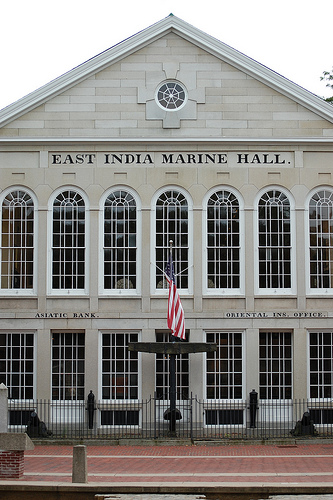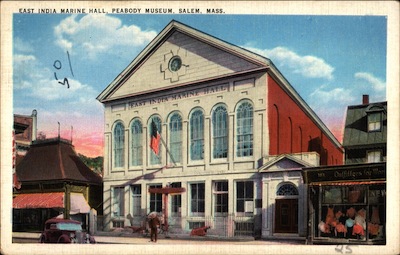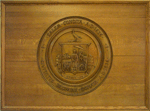Peabody Essex Museum: Difference between revisions
No edit summary |
No edit summary |
||
| (22 intermediate revisions by the same user not shown) | |||
| Line 7: | Line 7: | ||
"The East India Marine Society was founded in Salem, in Essex County, Massachusetts. Salem was also home to the Essex Historical Society (founded in 1821), which celebrated the area’s rich community history, and the Essex County Natural History Society (founded in 1833), which focused on the county’s natural wonders. In 1848, these two organizations merged to form the Essex Institute (the “Essex” in the Peabody Essex Museum’s name). This consolidation brought together extensive and far-ranging collections, including natural specimens, ethnological objects, books and historical memorabilia, all focusing on the area in and around Essex County. | "The East India Marine Society was founded in Salem, in Essex County, Massachusetts. Salem was also home to the Essex Historical Society (founded in 1821), which celebrated the area’s rich community history, and the Essex County Natural History Society (founded in 1833), which focused on the county’s natural wonders. In 1848, these two organizations merged to form the Essex Institute (the “Essex” in the Peabody Essex Museum’s name). This consolidation brought together extensive and far-ranging collections, including natural specimens, ethnological objects, books and historical memorabilia, all focusing on the area in and around Essex County. | ||
In the late 1860s, the Essex Institute refined its mission to the collection and presentation of regional art, history and architecture. In so doing, it transferred its natural history and archaeology collections to the East India Marine Society’s descendent organization, the Peabody Academy of Science (the “Peabody”). In turn, the Peabody, renamed for its great benefactor, the philanthropist George Peabody, transferred its historical collections to the Essex. | In the late 1860s, the [[Essex Institute]] refined its mission to the collection and presentation of regional art, history and architecture. In so doing, it transferred its natural history and archaeology collections to the East India Marine Society’s descendent organization, the Peabody Academy of Science (the “Peabody”). In turn, the Peabody, renamed for its great benefactor, the philanthropist George Peabody, transferred its historical collections to the Essex. | ||
In the early 20th century, the Peabody Academy of Science changed its name to the Peabody Museum of Salem and continued to focus on collecting international art and culture. Capitalizing on growing interest in early American architecture and historic preservation, the Essex Institute acquired many important historic houses and made them fit for historical interpretation. Prof. Frederick Ward Putnam (1839-1915) was the first director of the museum. | In the early 20th century, the Peabody Academy of Science changed its name to the Peabody Museum of Salem and continued to focus on collecting international art and culture. Capitalizing on growing interest in early American architecture and historic preservation, the Essex Institute acquired many important historic houses and made them fit for historical interpretation. Prof. Frederick Ward Putnam (1839-1915) was the first director of the museum. | ||
With their physical proximity, closely connected boards and overlapping collections, the possibility of consolidating the Essex and the Peabody had been discussed over the years. After in-depth studies showed the benefits of such a merger, the consolidation of these two organizations into the new PEM was effected in July 1992. The museum possessed more than 840,000 works of art and culture featuring maritime art and history; American art; Asian, Oceanic, and African art; Asian export art; two large libraries with over 400,000 books, manuscripts, and documents; and 22 historic buildings. Today’s collection has grown to include approximately 1 million works and Yin Yu Tang, the only complete Qing Dynasty house outside China" according to the PEM's website. | With their physical proximity, closely connected boards and overlapping collections, the possibility of consolidating the Essex and the Peabody had been discussed over the years. After in-depth studies showed the benefits of such a merger, the consolidation of these two organizations into the new PEM was effected in July 1992. The museum possessed more than 840,000 works of art and culture featuring maritime art and history; American art; Asian, Oceanic, and African art; Asian export art; two large libraries with over 400,000 books, manuscripts, and documents; and 22 historic buildings. Today’s collection has grown to include approximately 1 million works and Yin Yu Tang, the only complete Qing Dynasty house outside China" according to the PEM's website. | ||
A second expansion of the Peabody Essex Museum is planned, with a new wing three stories high and 5,000 square feet of gallery space, as well as a new garden. The completion date is summer of 2019. | |||
Peabody Essex Museum director, Dan Monroe, has announced his plan to retire in September of 2019. | |||
For more information about the Peabody Essex Museum historic buildings, see the entry: [[Peabody Essex Museum Historic Houses]] | For more information about the Peabody Essex Museum historic buildings, see the entry: [[Peabody Essex Museum Historic Houses]] | ||
For more information about Phillips Library, see entry: [[Phillips Library]] | |||
In early 2019, the PEM announced Brian Kennedy as their new director, on the retirement of long time director Dan Monroe. Presently serving as the President, Director, and CEO of the Toledo Museum of Art (TMA) in Ohio, Kennedy will assume his new role at PEM on July 15, 2019 | |||
In ealy 2019, the Peabody Essex Museum announced that it is renovating an old house on Brown Street known as the Bray House. Daniel Bray was a mariner and ship rigger The house was built in 1766 but the museum is restoring it to how it was in 1806. | |||
The historic anchor which was on display in front of the older portion of the museum prior to the recent expansion, was returned on Monday Sept. 17th. It had been in storage at the Rowley facility. | |||
Lynda Roscoe Hartigan will be the new director beginning Aug. 31, 2021, after Brian Kennedy resigned. She will be the first woman director of the library. | |||
[[Image:East_India_Marine_Hall.jpg]] | [[Image:East_India_Marine_Hall.jpg]] | ||
| Line 23: | Line 37: | ||
==See Also== | ==See Also== | ||
*Vertical File in Salem Collection - ''' | *Vertical File in Salem Collection - '''Peabody Essex Museum (#1 & #2)''' | ||
*Vertical File in Salem Collection - '''Essex Institute''' | *Vertical File in Salem Collection - '''Essex Institute''' | ||
*Vertical File in Salem Collection - Sister City-Huang Cun - China (original home of the Yin Yu Tan House) | *Vertical File in Salem Collection - '''Sister City-Huang Cun - China''' (original home of the Yin Yu Tan House) | ||
*[http://www.pem.org/ PEM] PEM Official Website | *[http://www.pem.org/ PEM] PEM Official Website | ||
| Line 34: | Line 48: | ||
*[http://evergreen.noblenet.org/eg/opac/record/1375980?locg=63 East India Marine Society and the Peabody Museum of Salem] W.M. Whitehill, 1949. | *[http://evergreen.noblenet.org/eg/opac/record/1375980?locg=63 East India Marine Society and the Peabody Museum of Salem] W.M. Whitehill, 1949. | ||
*[http://salem.noblenet.org/eg/opac/record/2172058?locg=63 The story of Essex County] article "Museums and Libraries", Vol. 2, p. 593-600 | |||
*[http://catalog.noblenet.org/eg/opac/record/1210825?locg=63 Visitor's Guide to Salem] 1953 ed. p.79-132 | *[http://catalog.noblenet.org/eg/opac/record/1210825?locg=63 Visitor's Guide to Salem] 1953 ed. p.79-132 | ||
| Line 45: | Line 61: | ||
*[http://catalog.noblenet.org/eg/opac/record/2058769?locg=63 Restoration of East India Marine Hall] Peabody Museum,1948 | *[http://catalog.noblenet.org/eg/opac/record/2058769?locg=63 Restoration of East India Marine Hall] Peabody Museum,1948 | ||
*[ | *[https://catalog.noblenet.org/eg/opac/record/4618201?locg=63 Collecting the Globe: the Salem East India Marine Society Museum] by G. Schwartz, 2020 | ||
*"Chinese house opens its doors in Salem" ''Boston Globe'', June 19, 2003, p. H 1-5 | *"Chinese house opens its doors in Salem" ''Boston Globe'', June 19, 2003, p. H 1-5 | ||
| Line 52: | Line 68: | ||
*[http://evergreen.noblenet.org/eg/opac/record/2382888?locg=63 Frederick Ward Putnam] Essex Institute Historical Collections, Vol. 52, p. 193-96 | *[http://evergreen.noblenet.org/eg/opac/record/2382888?locg=63 Frederick Ward Putnam] Essex Institute Historical Collections, Vol. 52, p. 193-96 | ||
*"The future of PEM: Museum expansion plans go before city boards" ''Salem News'', June 1, 2016, p. 1 | |||
*"Bulk of Phillips Library Collection won't return to Salem; museum officials get an earful from the public" ''Salem News'', Dec. 8, 2017, p. 1 | |||
*"Peabody Essex Museum director to retire" ''Salem News'', Oct. 12, 2018, p. 1 | |||
*"The man behind the Yin Yu Tang House: Huang Binggen, who assisted in bringing his ancestral home to PEM, died in August" ''Boston Sunday Globe'', Oct. 14, 2018, N4 | |||
*"Anchor returns to museum; historic artifact celebrated by Phillips Library supporters" ''Salem News'', Sept. 17, 2019, p. 1 | |||
Latest revision as of 10:29, 25 October 2023
Taken from the Peabody Essex Museum Website
"The roots of the Peabody Essex Museum date to the 1799 founding of the East India Marine Society, an organization of Salem captains and supercargoes who had sailed beyond either the Cape of Good Hope or Cape Horn. The society’s charter included a provision for the establishment of a “cabinet of natural and artificial curiosities,” which is what we today would call a museum. Society members brought to Salem a diverse collection of objects from the northwest coast of America, Asia, Africa, Oceania, India and elsewhere. By 1825, the society moved into its own building, East India Marine Hall, which today contains the original display cases and some of the very first objects collected" according to PEM's website.
Origins of the Name
"The East India Marine Society was founded in Salem, in Essex County, Massachusetts. Salem was also home to the Essex Historical Society (founded in 1821), which celebrated the area’s rich community history, and the Essex County Natural History Society (founded in 1833), which focused on the county’s natural wonders. In 1848, these two organizations merged to form the Essex Institute (the “Essex” in the Peabody Essex Museum’s name). This consolidation brought together extensive and far-ranging collections, including natural specimens, ethnological objects, books and historical memorabilia, all focusing on the area in and around Essex County.
In the late 1860s, the Essex Institute refined its mission to the collection and presentation of regional art, history and architecture. In so doing, it transferred its natural history and archaeology collections to the East India Marine Society’s descendent organization, the Peabody Academy of Science (the “Peabody”). In turn, the Peabody, renamed for its great benefactor, the philanthropist George Peabody, transferred its historical collections to the Essex.
In the early 20th century, the Peabody Academy of Science changed its name to the Peabody Museum of Salem and continued to focus on collecting international art and culture. Capitalizing on growing interest in early American architecture and historic preservation, the Essex Institute acquired many important historic houses and made them fit for historical interpretation. Prof. Frederick Ward Putnam (1839-1915) was the first director of the museum.
With their physical proximity, closely connected boards and overlapping collections, the possibility of consolidating the Essex and the Peabody had been discussed over the years. After in-depth studies showed the benefits of such a merger, the consolidation of these two organizations into the new PEM was effected in July 1992. The museum possessed more than 840,000 works of art and culture featuring maritime art and history; American art; Asian, Oceanic, and African art; Asian export art; two large libraries with over 400,000 books, manuscripts, and documents; and 22 historic buildings. Today’s collection has grown to include approximately 1 million works and Yin Yu Tang, the only complete Qing Dynasty house outside China" according to the PEM's website.
A second expansion of the Peabody Essex Museum is planned, with a new wing three stories high and 5,000 square feet of gallery space, as well as a new garden. The completion date is summer of 2019.
Peabody Essex Museum director, Dan Monroe, has announced his plan to retire in September of 2019.
For more information about the Peabody Essex Museum historic buildings, see the entry: Peabody Essex Museum Historic Houses
For more information about Phillips Library, see entry: Phillips Library
In early 2019, the PEM announced Brian Kennedy as their new director, on the retirement of long time director Dan Monroe. Presently serving as the President, Director, and CEO of the Toledo Museum of Art (TMA) in Ohio, Kennedy will assume his new role at PEM on July 15, 2019
In ealy 2019, the Peabody Essex Museum announced that it is renovating an old house on Brown Street known as the Bray House. Daniel Bray was a mariner and ship rigger The house was built in 1766 but the museum is restoring it to how it was in 1806.
The historic anchor which was on display in front of the older portion of the museum prior to the recent expansion, was returned on Monday Sept. 17th. It had been in storage at the Rowley facility.
Lynda Roscoe Hartigan will be the new director beginning Aug. 31, 2021, after Brian Kennedy resigned. She will be the first woman director of the library.
See Also
- Vertical File in Salem Collection - Peabody Essex Museum (#1 & #2)
- Vertical File in Salem Collection - Essex Institute
- Vertical File in Salem Collection - Sister City-Huang Cun - China (original home of the Yin Yu Tan House)
- PEM PEM Official Website
- Postcard Image courtesy of CardCow.com
- East India Marine Society and the Peabody Museum of Salem W.M. Whitehill, 1949.
- The story of Essex County article "Museums and Libraries", Vol. 2, p. 593-600
- Visitor's Guide to Salem 1953 ed. p.79-132
- Sketch of Salem By C.S. Osgood, p. 110-115
- The First Half-Century of the Essex Institute Salem Press, 1898.
- Handbook to the Collections of the Peabody Museum of Salem Ernest Dodge, 1949
- Restoration of East India Marine Hall Peabody Museum,1948
- Collecting the Globe: the Salem East India Marine Society Museum by G. Schwartz, 2020
- "Chinese house opens its doors in Salem" Boston Globe, June 19, 2003, p. H 1-5
- "History reborn: a stunning transformation for Peabody Essex Museum" Salem News, June 12, 2003, p. A1
- Frederick Ward Putnam Essex Institute Historical Collections, Vol. 52, p. 193-96
- "The future of PEM: Museum expansion plans go before city boards" Salem News, June 1, 2016, p. 1
- "Bulk of Phillips Library Collection won't return to Salem; museum officials get an earful from the public" Salem News, Dec. 8, 2017, p. 1
- "Peabody Essex Museum director to retire" Salem News, Oct. 12, 2018, p. 1
- "The man behind the Yin Yu Tang House: Huang Binggen, who assisted in bringing his ancestral home to PEM, died in August" Boston Sunday Globe, Oct. 14, 2018, N4
- "Anchor returns to museum; historic artifact celebrated by Phillips Library supporters" Salem News, Sept. 17, 2019, p. 1


